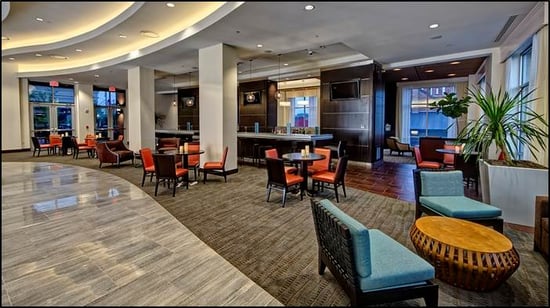The hotel lobby is rapidly changing from merely an entrance into a place that entrances. “We’re trying to make this more of an experience, a place to go to rather than a place to go through,” Alexandra Jaritz, global head for Tru by Hilton, told the New York Times.
But will you see a real ROI from transforming your lobby into a multifunctional hub for work, socializing and entertainment ? We spoke with Bob Bomholt, Director of Operations for hotel design-build firm Pinnacle South, to find out. Here are five reasons to consider a lobby revamp.
 |
| Hilton Garden Inn Downtown - Nashville, TN (Photo courtesy of Pinnacle South) |
1. Your old lobby isn’t working hard enough.
To maximize the return on your communal space, give the lobby a few new jobs. In the morning, it can be a coffee bar. Mid-day, it’s a café, and in the evenings, it becomes a cocktail bar. “That’s a great return on the exact same space,” Bomholt says. if your hotel lobby design includes flexible, multifunctional furniture, the same table used for breakfast in the morning can be raised to serve as a bar table in the evening. Switch on different lights, change the channels and the music, and guests will say, “Wow, is this the same room?”
The same goes for work spaces within the hotel, Bomholt says: “I don’t want to go down the hall to find the business center.” Work spaces can be incorporated into the lobby and made flexible, so they can serve as quiet places to concentrate or intimate nooks for client meetings.
2. Guests want to get out of the guestroom.
Some hoteliers hesitate to change their hotel lobby design to follow current trends. In 10 years, will guests still expect their hotel to be a social hub? “I think so,” Bomholt says. “Because I think people are all about the experience.” As the world becomes smaller and more people travel, he observes, travelers want to be immersed in their destination: “They don’t want to do it in the room, by themselves.” Hotels can facilitate this experience.
An experimental Marriott in Charlotte has redesigned its lobby with space to encourage conversation among guests, with an eye to making frequent travelers feel less lonely. The lobby in a Tru hotel, a new midscale concept from Hilton, has its own name: the Hive. It includes a work zone with private alcoves and sound-absorbing booths, a play zone with games and a large TV, a lounge zone where guests can sit in hammock-like chairs by large windows, and an eating zone with breakfast, coffee and a market.
3. Revamping the breakfast bar helps your hotel stand out.
Today’s health-minded, ingredient-conscious travelers may skip the wilted Danishes and bruised bananas offered in a conventional breakfast bar. They still want easy, fast self-service options, though.
Updating the lobby offers an opportunity to rethink the breakfast bar and turn it into a highlight of guests’ stay. “For obvious reasons, breakfast is still the meal that most hotel guests are likely to enjoy on-premise, and that makes it a selling point that can attract business and build sales,” Nestle Professional notes.
Tru is trying a fresh, customized take on a free breakfast bar: a selection of 30 toppings both healthy and sugary (like sprinkles) that guests use to customize Greek yogurt, oatmeal, bagels or doughnuts. Consider adding fresh, hot oatmeal or grits to your breakfast selection with a large-capacity Hamilton Beach Commercial rice cooker.
The one thing to keep in mind, Bomholt says, is to make breakfast as convenient as possible for guests. Invite them to linger, but don’t make them stand in line.
4. A distinctive lobby helps with brand differentiation.
While every hotel has its own brand standards for interior design, experienced interior designers can work within those standards to develop a unique and contemporary look for the lobby.
Pinnacle South recently designed the lobby for a Hilton Garden Inn in Brentwood, a suburb of Nashville. Designers united the traditional with modern, choosing plush furniture, warm lighting and bold, contrasting textures. “I feel like I’m walking into the Ritz,” Bomholt says. “And it does not take that much additional investment to take that front entrance and create that initial impression.”
5. Lobby updates help you stay competitive.
Hotel chains are trying to differentiate themselves by spinning off new brands aimed at millennials: Canopy by Hilton. Centric by Hyatt. Moxy by Marriott. This presents a problem for owners of established hotels. If the price is right, novelty-seeking travelers will choose a brand-new boutique hotel over a slightly dated legacy brand. If you notice guests decamping for newer properties, “you need to up your game,” counsels Bomholt.
An experienced design-and-build firm can update the lobby with minimal disruption to guests. And the ROI is rapid, Bomholt says. “If it’s done well, it’s done smart, they’ll start to see the impact right away.”
Want to show off your stunning lobby, or your beautiful breakfast bar? Tell us about it and we may feature your property in a future post.


